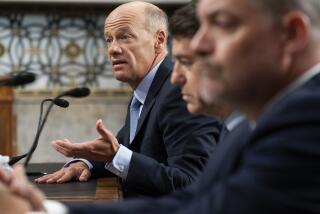$95-Billion Deal for Bank Fund, S&L; Cleanup OKd : Legislation: Congress’ action means that bank deposits up to $100,000 are still protected and the thrift bailout can continue through April.
- Share via
WASHINGTON — An apprehensive Congress, trying to buttress the nation’s fragile financial system, voted Wednesday to provide $95 billion to rescue the bank insurance fund and pay for the continuing costly cleanup of failed savings and loan associations.
The unhappy legislators approved a $70-billion line of credit for the deposit insurance fund, rejecting the Bush Administration’s proposal to give banks broad new powers to move across state lines and to market securities and insurance.
“This is truly an urgent measure,” said Senate Banking Committee Chairman Donald Riegle (D-Mich.), warning that the fund is in imminent danger of failing in its guarantee to protect bank deposits up to $100,000.
The legislation calls for banks to repay the money during the next 15 years, but Riegle and other key members of Congress fear that a taxpayer bailout is virtually inevitable. More banks plagued by bad real estate loans will fail, making it impossible for the industry to repay the $70 billion, according to Riegle and others worried about the stability of the banking system.
These critics are frightened that the weakening of the bank insurance fund could become a replay of the savings and loan crisis. Hundreds of thrifts weakened by dubious real estate investments and other risky ventures plunged into insolvency during the late 1980s, wiping out the insurance fund protecting deposits and precipitating a taxpayer bailout.
The persistence of that crisis prompted Congress’ second big vote Wednesday on financial issues, a grant of up to $25 billion through next April to cover the mounting expenses of the Resolution Trust Corp., the agency responsible for seizing insolvent S&Ls; and paying off their depositors.
The RTC already has spent $80 billion in taxpayers’ funds to pay off the accounts of 19 million Americans at failed thrifts. And the Administration asked for $80 billion more.
But Congress balked and decided only to approve funding for the next four months because of its distrust of the “very slow and sluggish” RTC, Riegle said during the brief debate Wednesday.
In an attempt to improve the RTC’s efficiency, the bill combines the agency’s two governing boards into one and gives more power and autonomy to the chief executive.
There was no enthusiasm among legislators for either vote.
“Every one of us would prefer we didn’t face it,” House Banking Committee Chairman Henry Gonzalez (D-Tex.) said before the RTC vote. “But it’s a job we must do.”
The House minority leader, Rep. Robert Michel (R-Ill.), said, “We have, frankly, no alternative” because millions of Americans have accounts at thrifts already insolvent or likely to collapse in the future. “We’ve got to make them whole,” Michel said. “We can’t default on that responsibility.”
Members of the House grudgingly approved the bills but managed to avoid being linked by name to the unpopular issues. The House approved the new borrowing authority for the bank fund by a voice vote. The RTC funding bill was passed by an unusual standing vote of 112 to 63, with members rising from their seats to be counted without having their names recorded. Rep. William Dannemeyer (R-Fullerton) was rebuffed in efforts to force a recorded vote.
The Senate had recorded votes, approving the bank measure by 68 to 15 and the RTC funding by 44 to 33.
The limited content of both bills represented a major disappointment for the Administration. It sought a major expansion of bank activities and received nothing but desperately needed financial aid for the insurance fund. It wanted $80 billion for the S&L; cleanup but was told to spend what it needs for the thrift cleanup in the next four months, with a maximum of $25 billion.
A disappointed Treasury Secretary Nicholas Brady said the banking bill is “a pale shadow of the fundamental reforms the Administration proposed and that the nation’s banking system so badly needs.” Congress has done nothing to restore the industry’s health and ability to attract capital, he said. But the President will sign the bill “so that all Americans know their bank deposits are safe,” the Treasury secretary said.
He was equally critical of the RTC bill, saying “a stop-and-start process will only drive up the cost of the cleanup.”
The bill to buttress the bank insurance fund was a sharply focused piece of legislation, providing the new borrowing authority and establishing a series of “trip wires” for federal regulators to take action against troubled banks.
The regulators will have the authority to restrict dividend payments, fire bank executives and managers, force a merger with a health institution and order the sale of stock to raise capital.
Banks will be grouped into five categories, depending on their financial health, and the regulators can take increasingly tough action as the institution becomes weaker. They can move to close a bank even before its capital is exhausted.
The law is designed to avoid big losses for the insurance fund by early intervention in the affairs of troubled banks.
The regulators want to be able to move quickly because the viability of many financial institutions is dangerously dependent on the precarious condition of real estate markets.
Key Provisions of the Bills
Here are key components of the banking and savings institution bills.
The banking bill would: * Replenish the nearly insolvent Federal Deposit Insurance Corp. by expanding by around $70 billion its authority to borrow from taxpayers. * Require regulators in most cases to seize weak banks before they fail. * Forbid most “too-big-to-fail bailouts,” which protect deposits over the $100,000-per-account insurance limit. * Oblige banks to clearly and uniformly disclose interest rates, fees and other terms of savings and checking accounts.
The S&L; bill would:
* Provide the Resolution Trust Corp. with enough taxpayer funds--up to $25 billion--to keep operating until April 1. * Streamline the RTC’s cumbersome administrative structure by creating a strong chief executive and combining the agency’s two boards.
More to Read
Sign up for Essential California
The most important California stories and recommendations in your inbox every morning.
You may occasionally receive promotional content from the Los Angeles Times.













